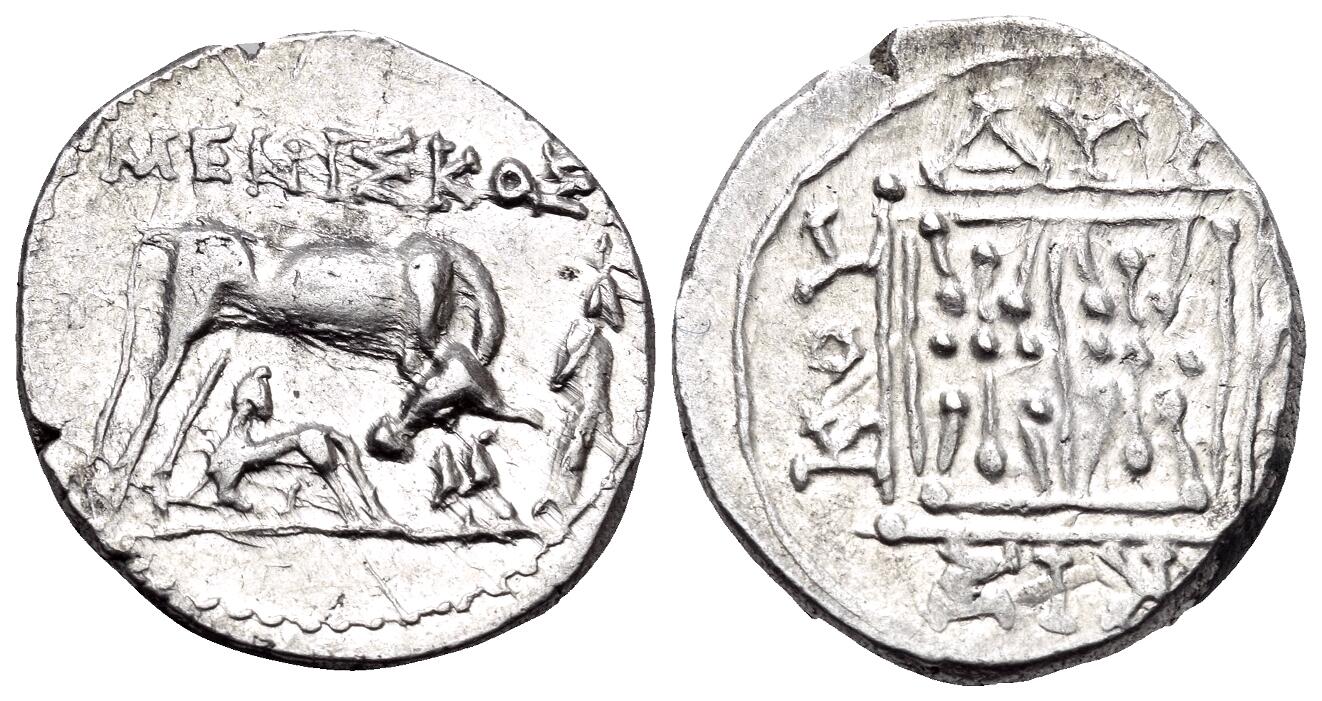Dyrrhachium (Roman Republic), silver, drachms (calf suckling cow/double stellate pattern) (80-55 BCE)
From SILVER
(Redirected from S 1438 - Dyrrhachium (Roman Republic), silver, drachms (80-55 BCE))
80 BCE - 55 BCE Silver 44,093 kg
Description
| ObverseInscription or printing placed on the obverse.: | ΜΕΝΙΣΚΟΣ (Greek).Cow standing right, head turned to nudge suckling calf standing left below, to right, statue of Isis facing |
| ReverseInscription or printing placed on the reverse.: | ΔΥΡ ΛΥ-ΚΙΣ-ΚΟΥ (Greek).Divided double square containing two stellate designs |
Mint and issuing power
| MintIdentifies the place of manufacture or issue of a numismatic object.: | Dyrrhachium | Ancient regionAncient region.: | Illyricum | Modern countryModern country: Albania | AuthorityIdentifies the issuing power. The authority can be "pretended" when the name or the portrait of X is on the coin but he/she was not the issuing power. It can also be "uncertain" when there is no mention of X on the coin but he/she was the issuing power according to the historical sources: | Roman Republic |
Chronology
| FromIdentifies the initial date in a range assigned in a numismatic context. | 80 BCE | toIdentifies the final date in a range assigned in a numismatic context.. | 55 BCE | PeriodTime period of the numismatic object.: Hellenistic 323-30 BC |
Physical description
| MetalThe physical material (usually metal) from which an object is made.: | Silver |
Median weightMedian of the weights of numismatic objects (in grams). in grams | 3.30 | DenominationTerm indicating the value of a numismatic object. Examples: tetradrachm, chalkous, denarius.: | drachma |
StandardStandard.: |
Image

S1438 Dyrrhachium V.jpg [1]
References
| Die study referencePublication of the study: | Meta 20151Meta 2015, p. 118-130 (Series III, phase V) | ||
| Coin series referenceReference to coin series study: | Sear I2Sear I, n° 1901 | ||
| Coin series web referenceCoin series web references: | |||
Obverse dies distribution
Reverse dies distribution
no distribution is available
Quantification
| Number of obversesNumber of obverse dies. ᵖ (o) | 274 | Number of singletons (o1)The number of singleton coins. ᵖ | 173 |
| Number of reverse diesNumber of reverse dies. (r) | 267 | Number of coinsNumber of coins. (n) | 408 |
| Coins per obverse dieNumber of coins per obverse die. (n/o) | 1.49 | Coins per reverse dieNumber of coins per reverse die. (n/r) | 1.53 |
| Reverse per obverse ratioRatio of obverse dies divided by reverse dies. (r/o) | 0.97 | Percentage of singletons (o1)number of coins (n) divided by the number of singletons (o1) ᵖ | 63.14 % |
| Original number of dies (O) (Carter 1983 formula)The estimation of the number of coins according to Carter 1983 ᵖ | 668.08 | Coins struck if 20,000 as average productivity per dieCoins made if the average productivity for obverses (according to Carter) is 20,000. ᵖ | 13,361,600 |
| Original number of dies (O) (Esty 2011 formula)The estimation of the number of coins according to the singleton formula in Esty 2011 ᵖ (O) | 834.27 | Survival rate if 20,000 as average productivity per dieSurvival rate if average productivity is 20,000. ᵖ | 0.00003 |
| Coverage (o = % of O) (Esty 1984 formula)Esty 1984 - coverage (% of O) ᵖ (o = % of O) | 57.6% | Die productivity if survival rate 1/2,000Average productivity if survival rate is 1/2,000. ᵖ | 1,221.41 |
| Weight of silver (in kg) if 20,000 coins per die (O = Carter formula)Carter 1983 * Median weight * 20000 (*10 if gold or electrum) ᵖ | 44,093 kg <br /> 44,093 kg | Die productivity if survival rate 1/5,000Average productivity if survival rate is 1/5,000. ᵖ | 3,053.53 |
Remarks